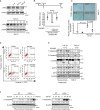Liver X Receptor α-Induced Cannabinoid Receptor 2 Inhibits Ubiquitin-Specific Peptidase 4 Through miR-27b, Protecting Hepatocytes From TGF-β
- PMID: 31592043
- PMCID: PMC6771303
- DOI: 10.1002/hep4.1415
Liver X Receptor α-Induced Cannabinoid Receptor 2 Inhibits Ubiquitin-Specific Peptidase 4 Through miR-27b, Protecting Hepatocytes From TGF-β
Abstract
Liver X receptor-alpha (LXRα) acts as a double-edged sword in different biological situations. Given the elusive role of LXRα in hepatocyte viability, this study investigated whether LXRα protects hepatocytes from injurious stimuli and the underlying basis. LXRα activation prevented hepatocyte apoptosis from CCl4 challenges in mice. Consistently, LXRα protected hepatocytes specifically from transforming growth factor-beta (TGF-β), whereas LXRα deficiency aggravated TGF-β-induced hepatocyte injury. In the Gene Expression Omnibus database analysis for LXR-/- mice, TGF-β receptors were placed in the core network. Hierarchical clustering and correlation analyses enabled us to find cannabinoid receptor 2 (CB2) as a gene relevant to LXRα. In human fibrotic liver samples, both LXRα and CB2 were lower in patients with septal fibrosis and cirrhosis than those with portal fibrosis. LXRα transcriptionally induced CB2; CB2 then defended hepatocytes from TGF-β. In a macrophage depletion model, JWH133 (a CB2 agonist) treatment prevented toxicant-induced liver injury. MicroRNA 27b (miR-27b) was identified as an inhibitor of ubiquitin-specific peptidase 4 (USP4), deubiquitylating TGF-β receptor 1 (TβRI), downstream from CB2. Liver-specific overexpression of LXRα protected hepatocytes from injurious stimuli and attenuated hepatic inflammation and fibrosis. Conclusion: LXRα exerts a cytoprotective effect against TGF-β by transcriptionally regulating the CB2 gene in hepatocytes, and CB2 then inhibits USP4-stabilizing TβRI through miR-27b. Our data provide targets for the treatment of acute liver injury.
© 2019 The Authors. Hepatology Communications published by Wiley Periodicals, Inc., on behalf of the American Association for the Study of Liver Diseases.
Figures







References
-
- Racanelli V, Rehermann B. The liver as an immunological organ. Hepatology 2006;43:S54‐S62. - PubMed
-
- Takehara T, Tatsumi T, Suzuki T, Rucker EB, Hennighausen L, Jinushi M, et al. Hepatocyte‐specific disruption of Bcl‐xL leads to continuous hepatocyte apoptosis and liver fibrotic responses. Gastroenterology 2004;127:1189‐1197. - PubMed
-
- Kohro T, Nakajima T, Wada Y, Sugiyama A, Ishii M, Tsutsumi S, et al. Genomic structure and mapping of human orphan receptor LXR alpha: upregulation of LXRa mRNA during monocyte to macrophage differentiation. J Atheroscl Thromb 2000;7:145‐151. - PubMed
LinkOut - more resources
Full Text Sources

